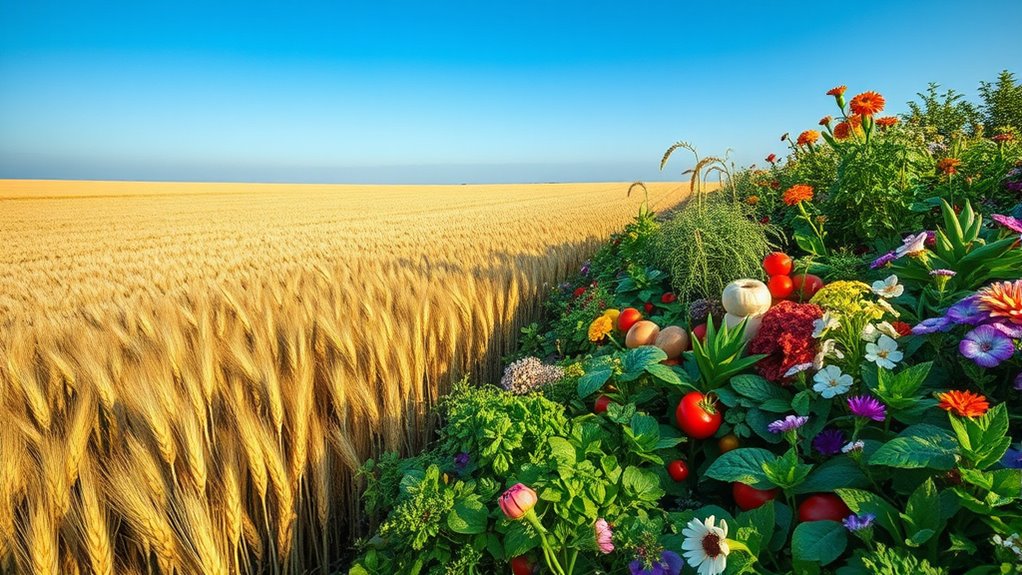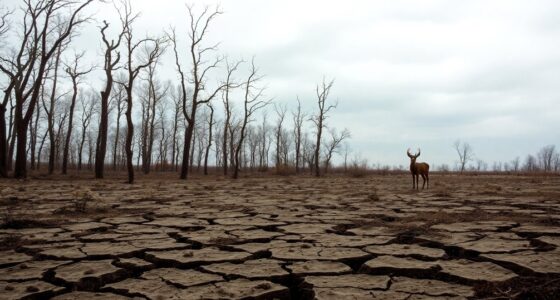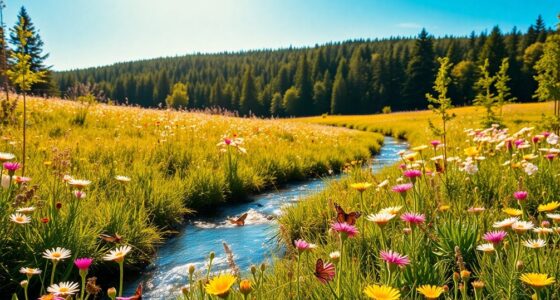Monoculture involves growing a single crop over large areas, which reduces biodiversity, harms soil health, and increases vulnerability to pests and diseases. In contrast, polyculture mixes multiple crops, supporting diverse ecosystems, improving soil nutrients, and naturally controlling pests. While monoculture can be more profitable short-term, it often leads to environmental issues. To understand how these practices affect ecosystem stability and ways to promote sustainable farming, keep exploring the details behind these methods.
Key Takeaways
- Monoculture reduces biodiversity by growing a single crop, creating uniform environments vulnerable to pests, diseases, and environmental stress.
- Polyculture promotes biodiversity by planting multiple crops, supporting diverse ecosystems and natural pest control.
- Monocultures often deplete soil nutrients and increase erosion, negatively impacting soil microbial diversity and ecosystem health.
- Polycultures enhance soil health through crop rotation and cover cropping, boosting microbial diversity and ecosystem resilience.
- Habitat fragmentation from monoculture practices threatens native species and reduces overall biodiversity.
Defining Monoculture and Polyculture
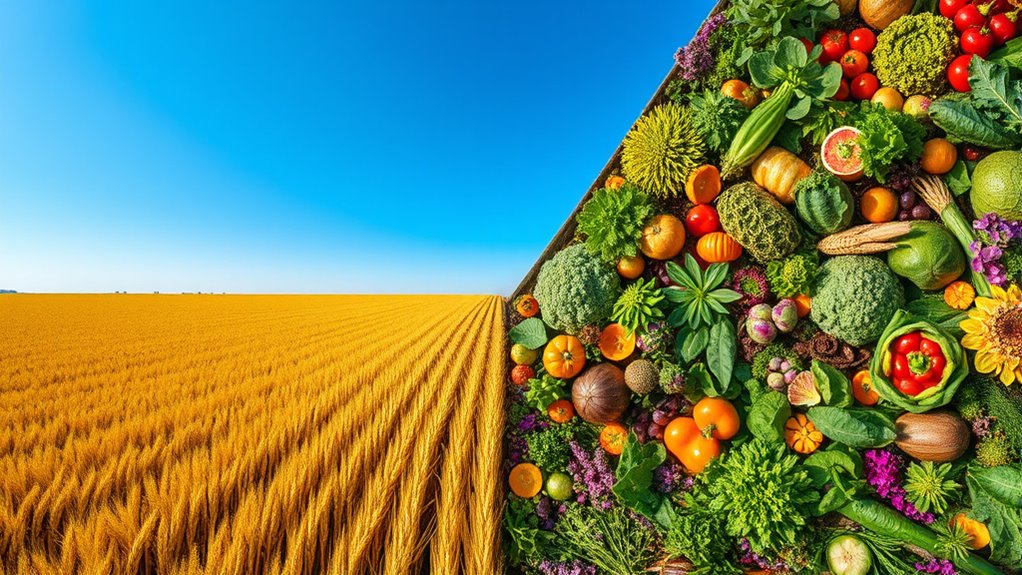
Have you ever wondered how different farming methods impact biodiversity? Farming monocultures involve growing a single crop over a large area, often leading to reduced biodiversity. This practice simplifies the landscape, making it easier to manage but also increasing vulnerability to pests and diseases. In contrast, crop diversification or polyculture involves planting multiple crops together, creating a more complex ecosystem. This diversity supports a wider range of insects, birds, and other wildlife, fostering a healthier environment. Monocultures tend to decrease natural habitat variety, while polycultures promote resilience by mimicking natural plant communities. Incorporating natural materials like wood and stone in agricultural landscapes can further enhance biodiversity and ecological balance. Additionally, adopting biodiversity-friendly practices can help mitigate the negative impacts associated with monoculture systems. Recognizing the importance of ecosystem diversity encourages sustainable farming that benefits both farmers and the environment. Understanding these differences helps you see how farming choices directly influence the variety of life in agricultural landscapes, shaping the overall health and sustainability of ecosystems.
Effects on Soil Health and Ecosystem Stability

Your farming practices directly impact soil health and ecosystem stability. When you rely on monoculture, you risk depleting soil nutrients and increasing the spread of pests and diseases. Over time, these issues weaken the resilience of the entire ecosystem. Implementing diverse cropping systems can enhance biodiversity and promote more sustainable farming. Additionally, incorporating crop rotation and polyculture techniques can improve color accuracy and overall productivity of the land.
Soil Nutrient Depletion
Soil nutrient depletion occurs when essential minerals and organic matter are continuously removed faster than they can be replenished, often due to intensive farming practices. Without strategies like crop rotation and cover cropping, your soil loses crucial nutrients, weakening its structure and fertility. This degradation harms plant growth and reduces biodiversity, risking long-term ecosystem stability. To visualize this, consider the following:
| Healthy Soil | Depleted Soil |
|---|---|
| Rich in nutrients | Lacks essential minerals |
| Supports diverse life | Becomes barren and fragile |
| Sustains crops naturally | Requires chemical inputs |
Embracing crop rotation and cover cropping helps replenish nutrients, protecting your soil’s future and maintaining ecological balance. Neglecting these practices accelerates degradation, threatening your farm’s productivity and the environment. Additionally, soil erosion can further deplete vital topsoil layers, exacerbating nutrient loss and destabilizing ecosystems.
Pest and Disease Spread
Did you know that the spread of pests and diseases can profoundly undermine soil health and threaten ecosystem stability? When pests attack repeatedly in monocultures, they can deplete soil nutrients and disrupt microbial balance. This makes the soil less fertile and more vulnerable to erosion. Implementing crop rotation helps break pest and disease cycles, reducing the need for chemical interventions that can harm soil organisms. Crop diversification strategies further control pest populations naturally, minimizing chemical use and supporting soil biodiversity. By diversifying your crops and adopting IPM, you lessen the risk of widespread outbreaks, which helps maintain soil integrity and stabilizes the surrounding ecosystem. These practices promote healthier soil and resilient ecosystems, ensuring sustainable productivity over time. Incorporating iterative processes into your farming practices allows for ongoing refinement and adaptation to environmental challenges, enhancing overall farm resilience. Additionally, fostering soil microbial diversity plays a vital role in maintaining soil health and supporting plant growth, which is crucial for sustainable farming systems. Furthermore, integrating cover cropping can also improve soil structure and protect against erosion, contributing to a more resilient and sustainable agricultural system.
Ecosystem Resilience Decline
When farming practices lack diversity and fail to protect natural habitats, ecosystems become more vulnerable to disturbances, leading to a decline in resilience. Without genetic diversity, soils lose essential nutrients and become more prone to erosion. Monocultures hinder crop rotation, reducing soil microorganisms that sustain healthy soil structure. This decline weakens ecosystem stability, making farms susceptible to pests, droughts, and diseases. To improve resilience, you should consider: 1. Incorporating diverse plant varieties to boost genetic diversity. 2. Practicing crop rotation to maintain soil fertility. 3. Preserving natural habitats to support beneficial organisms. Additionally, facilitating collaboration among farmers and researchers can accelerate the adoption of sustainable practices that enhance biodiversity and ecosystem health. Recognizing the importance of biodiversity is crucial for maintaining long-term ecological balance.
Impact on Plant and Animal Diversity

Farming practices often lead to a decline in species richness, reducing the variety of plants and animals in the area. Habitat fragmentation caused by agriculture can isolate populations, making it harder for species to survive and reproduce. These changes threaten the overall health and resilience of local ecosystems. Additionally, implementing vertical storage solutions and other space-maximizing techniques can help reduce the need for expanding farmland, thereby lessening habitat disruption. Using affiliates and other partnerships, farmers and conservationists can find sustainable ways to balance productivity with biodiversity preservation. Proper storing of seeds and plant material can also support biodiversity by maintaining genetic diversity and enabling reforestation or crop diversification efforts. Regular monitoring and signs of spoilage are essential to ensure the health of stored plant material and prevent the spread of pests or diseases.
Species Richness Decline
The decline in species richness resulting from modern farming practices considerably impacts both plant and animal diversity. You may notice fewer native plants and animals in areas dominated by monoculture. This loss occurs because practices like continuous cropping reduce habitat variety and disrupt ecosystems. For instance:
- Relying on monoculture limits plant variety, making it harder for native species to survive.
- Reduced crop rotation weakens soil health and diminishes habitats for insects and soil organisms.
- Heavy use of pest control chemicals kills beneficial insects and disrupts food chains.
These practices create a less resilient environment, decreasing overall biodiversity. As species decline, ecosystems become more fragile, and the natural balance is upset. Understanding environmental impacts is crucial for promoting sustainable farming methods that enhance biodiversity and ecological stability.
Habitat Fragmentation Effects
Have you ever wondered how breaking up continuous habitats affects plant and animal life? Habitat fragmentation occurs when urban encroachment or farming creates isolated patches, disrupting ecosystems. This fragmentation reduces the size of habitat patches, making it harder for species to find food, mates, and shelter. It also isolates populations, decreasing genetic diversity and increasing extinction risks. To combat these effects, creating habitat corridors becomes essential; these natural passages connect fragmented areas, allowing wildlife movement and gene flow. Without corridors, species struggle to survive in fragmented landscapes, leading to declines in biodiversity. As AI systems continue to evolve, understanding AI bifurcation and its implications can inform smarter conservation strategies that leverage technology for habitat monitoring and restoration. So, when farming practices cause habitat fragmentation, they not only threaten individual species but also weaken the entire ecosystem’s resilience. Managing fragmentation through thoughtful planning helps preserve plant and animal diversity.
Pest and Disease Management Strategies
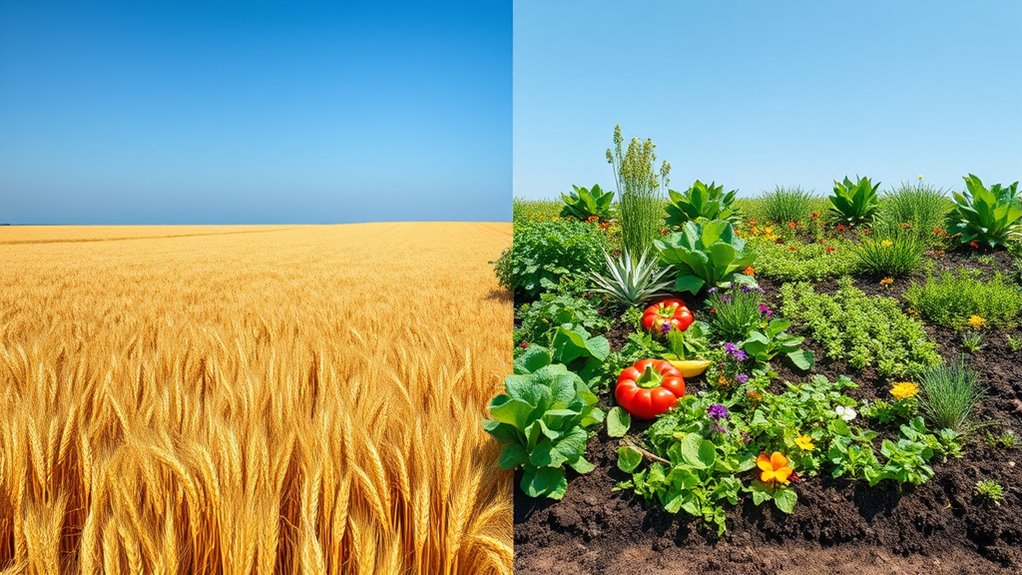
Effective pest and disease management strategies are essential for maintaining healthy crops while minimizing environmental impact. By implementing methods like crop rotation, you can break pest and disease cycles, reducing reliance on chemicals. Biological control involves introducing natural predators or beneficial organisms to manage pests sustainably. These approaches help preserve biodiversity by avoiding broad-spectrum pesticides that harm non-target species. To deepen your understanding, consider these strategies:
Effective pest management reduces chemicals, supports biodiversity, and promotes resilient, healthy crops.
- Rotate crops seasonally to disrupt pest habitats.
- Use biological control agents such as ladybugs or predatory nematodes.
- Integrate cultural practices, like selecting resistant varieties, to prevent outbreaks.
- Incorporating Glycolic acid in pest management can also assist in controlling certain plant pathogens and improving crop resilience. Additionally, understanding the role of crop diversity is vital, as it enhances ecosystem stability and reduces the risk of widespread pest infestations. Recognizing angel number symbolism can also provide insights into timing and opportunities for implementing these practices effectively. Employing real-time monitoring systems further enables prompt responses to emerging threats, minimizing potential damage. Implementing integrated pest management practices further supports sustainable farming by combining biological, cultural, and chemical controls in a balanced approach. Together, these strategies promote healthier ecosystems, support biodiversity, and create more resilient farming systems.
Economic and Environmental Trade-offs

Balancing economic gains with environmental sustainability presents a complex challenge for farmers. Monoculture often offers higher economic benefits through increased efficiency and simplified management, leading to short-term profits. However, it also poses significant environmental risks, such as soil degradation, reduced biodiversity, and increased vulnerability to pests and diseases. In contrast, polyculture can mitigate these risks by promoting diverse ecosystems, but it may require more labor, time, and investment, which can cut into immediate economic returns. You need to weigh these trade-offs carefully. While monoculture boosts short-term income, it can threaten long-term sustainability. Conversely, polyculture might lower initial profits but supports healthier ecosystems, ensuring productivity and resilience over time. Finding a balance between economic benefits and environmental health is essential for sustainable farming. Sustainable practices like integrating Waldorf-inspired natural materials in agriculture can further enhance ecological balance and promote biodiversity, supporting biodiversity and ecosystem health in agricultural landscapes. Incorporating sound design principles, such as creating awareness about environmental impacts through educational campaigns, can also help promote sustainable farming methods. Implementing crop diversification strategies is another way to foster resilience and ecological stability in farming systems. Additionally, understanding the role of biodiversity in maintaining soil health and pest control can help farmers develop more sustainable practices.
Promoting Biodiversity Through Sustainable Practices
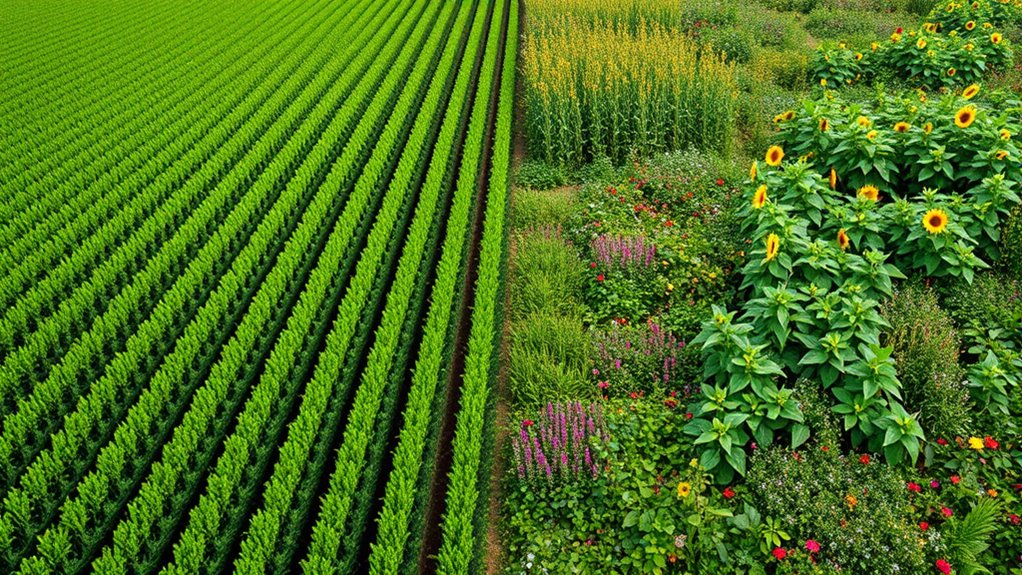
Implementing sustainable farming practices can considerably enhance biodiversity on agricultural lands. By adopting methods like crop rotation and cover cropping, you foster diverse habitats and reduce pest risks. Here are three ways sustainable practices promote biodiversity:
- Crop rotation breaks pest cycles and enriches soil health.
- Cover cropping provides habitat and food for beneficial insects.
- Reduced chemical use minimizes harm to native species.
- Understanding local laws and regulations can facilitate the adoption of sustainable practices.
Using crop rotation prevents monocultures and encourages plant diversity, supporting various wildlife. Cover cropping adds plant variety and conserves soil moisture, creating a thriving ecosystem. These practices not only boost biodiversity but also improve long-term farm productivity and resilience. Embracing sustainable land management helps create a balanced environment where crops and native species coexist, ensuring sustainable land management for future generations.
Frequently Asked Questions
How Do Monoculture and Polyculture Affect Water Usage Efficiency?
You’ll find that monoculture often reduces irrigation efficiency because it relies heavily on uniform water application, leading to water wastage. In contrast, polyculture promotes water conservation by creating diverse plant systems that naturally improve soil retention and reduce water runoff. This diversity allows you to optimize water usage, making irrigation more efficient and sustainable. Ultimately, polyculture helps you conserve water while maintaining healthy crops, unlike monoculture’s often higher water demands.
What Are the Long-Term Economic Impacts of Each Farming Practice?
You’ll find that monoculture can boost short-term profits but risks economic resilience by making your farm vulnerable to pests and market fluctuations. Conversely, polyculture offers greater market stability and long-term economic benefits, as diversified crops reduce dependency on a single commodity. By practicing polyculture, you build resilience against crop failures and price drops, ensuring steadier income and a more sustainable farm economy over time.
How Do These Practices Influence Local Climate Conditions?
You’ll notice that monoculture can decrease soil moisture and create microclimate effects, like higher temperatures and reduced airflow, due to uniform crop cover. Conversely, polyculture promotes diverse plantings that improve soil moisture retention and buffer microclimate variations. By choosing polyculture, you help stabilize local climate conditions, supporting healthier ecosystems. Monoculture’s simplified landscape often intensifies microclimate fluctuations, which can negatively affect both crops and surrounding habitats.
Can Monoculture or Polyculture Support Native Wildlife Better?
Ever wonder which farming practice better supports native wildlife? Polyculture encourages habitat diversity, providing food and shelter for native species, making it preferable. Monoculture, with its uniform crops, offers limited resources, reducing habitat quality. By fostering diverse habitats, polyculture sustains a broader range of native species, helping maintain local biodiversity. So, if you’re committed to supporting native wildlife, embracing polyculture practices is the way to go.
What Role Do Government Policies Play in Promoting Sustainable Farming?
Government policies play a vital role in promoting sustainable farming by shaping incentives and regulations. You’ll find that farming subsidies can encourage practices like polyculture, which support biodiversity, while strict regulatory policies can limit harmful monoculture practices. When the government prioritizes sustainable methods, you’re more likely to adopt eco-friendly techniques that protect native wildlife and guarantee long-term farm health. Effective policies make it easier for you to balance productivity with environmental conservation.
Conclusion
By choosing between monoculture and polyculture, you hold the power to shape the future of farming and biodiversity. Imagine your fields as a vibrant symphony—monoculture as a solo, and polyculture as an orchestra. When you embrace diverse planting practices, you not only nurture healthier soils and resilient ecosystems but also play your part in safeguarding our planet’s rich tapestry of life. The choice is yours—will you be the conductor of a thriving, balanced Earth?
